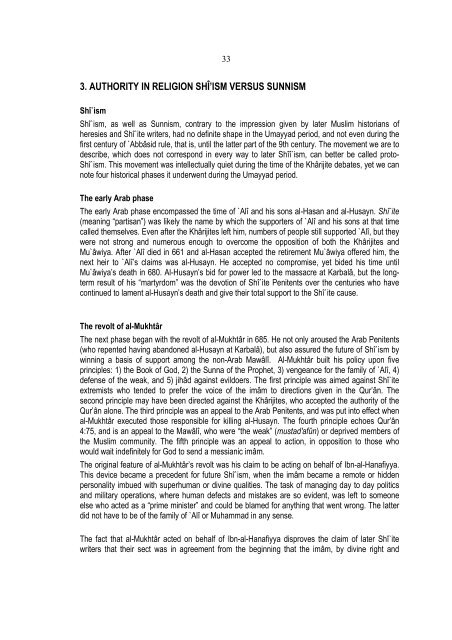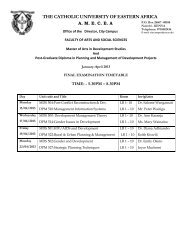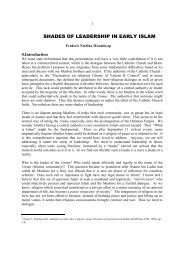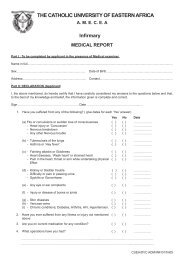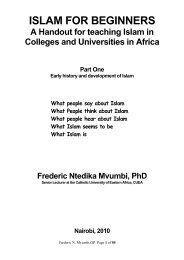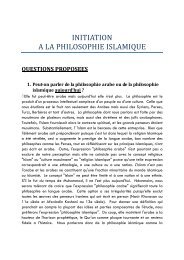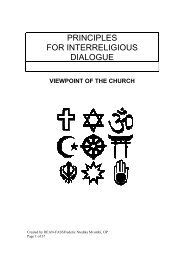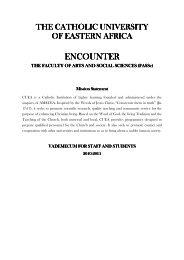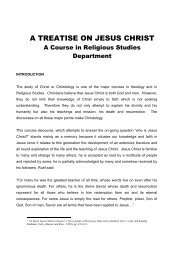INTRODUCTION TO ISLAMIC THEOLOGY.pdf - CUEA
INTRODUCTION TO ISLAMIC THEOLOGY.pdf - CUEA
INTRODUCTION TO ISLAMIC THEOLOGY.pdf - CUEA
You also want an ePaper? Increase the reach of your titles
YUMPU automatically turns print PDFs into web optimized ePapers that Google loves.
333. AUTHORITY IN RELIGION SHÎ’ISM VERSUS SUNNISMShî`ismShî`ism, as well as Sunnism, contrary to the impression given by later Muslim historians ofheresies and Shî`ite writers, had no definite shape in the Umayyad period, and not even during thefirst century of `Abbâsid rule, that is, until the latter part of the 9th century. The movement we are todescribe, which does not correspond in every way to later Shîî`ism, can better be called proto-Shî`ism. This movement was intellectually quiet during the time of the Khârijite debates, yet we cannote four historical phases it underwent during the Umayyad period.The early Arab phaseThe early Arab phase encompassed the time of `Alî and his sons al-Hasan and al-Husayn. Shî`ite(meaning “partisan”) was likely the name by which the supporters of `Alî and his sons at that timecalled themselves. Even after the Khârijites left him, numbers of people still supported `Alî, but theywere not strong and numerous enough to overcome the opposition of both the Khârijites andMu`âwiya. After `Alî died in 661 and al-Hasan accepted the retirement Mu`âwiya offered him, thenext heir to `Alî’s claims was al-Husayn. He accepted no compromise, yet bided his time untilMu`âwiya’s death in 680. Al-Husayn’s bid for power led to the massacre at Karbalâ, but the longtermresult of his “martyrdom” was the devotion of Shî`ite Penitents over the centuries who havecontinued to lament al-Husayn’s death and give their total support to the Shî`ite cause.The revolt of al-MukhtârThe next phase began with the revolt of al-Mukhtâr in 685. He not only aroused the Arab Penitents(who repented having abandoned al-Husayn at Karbalâ), but also assured the future of Shî`ism bywinning a basis of support among the non-Arab Mawâlî. Al-Mukhtâr built his policy upon fiveprinciples: 1) the Book of God, 2) the Sunna of the Prophet, 3) vengeance for the family of `Alî, 4)defense of the weak, and 5) jihâd against evildoers. The first principle was aimed against Shî`iteextremists who tended to prefer the voice of the imâm to directions given in the Qur’ân. Thesecond principle may have been directed against the Khârijites, who accepted the authority of theQur’ân alone. The third principle was an appeal to the Arab Penitents, and was put into effect whenal-Mukhtâr executed those responsible for killing al-Husayn. The fourth principle echoes Qur’ân4:75, and is an appeal to the Mawâlî, who were “the weak” (mustad'afûn) or deprived members ofthe Muslim community. The fifth principle was an appeal to action, in opposition to those whowould wait indefinitely for God to send a messianic imâm.The original feature of al-Mukhtâr’s revolt was his claim to be acting on behalf of Ibn-al-Hanafiyya.This device became a precedent for future Shî`ism, when the imâm became a remote or hiddenpersonality imbued with superhuman or divine qualities. The task of managing day to day politicsand military operations, where human defects and mistakes are so evident, was left to someoneelse who acted as a “prime minister” and could be blamed for anything that went wrong. The latterdid not have to be of the family of `Alî or Muhammad in any sense.The fact that al-Mukhtâr acted on behalf of Ibn-al-Hanafiyya disproves the claim of later Shî`itewriters that their sect was in agreement from the beginning that the imâm, by divine right and


